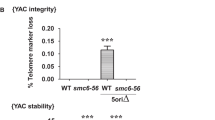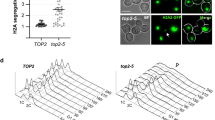Abstract
We have constructed circular minichromosomes, ranging in size from 36 to 110 kb, containing the centromeric repeats of Schizosaccharomyces pombe cen3. Comparison of their mitotic stability showed that the circular minichromosomes became more unstable with increasing in size, however, a linear cen3 minichromosome, which is almost the same size as the largest circular one tested, does not show such instability. High levels of expression of the top2 + (type II DNA topoisomerase; topo II) but not top1 + gene (type I DNA topoisomerase) suppressed the instability of the largest circular minichromosome, whereas partial inactivation of topo II dramatically destabilized the minichromosome. A mutant topo II, defective in nuclear localization but still retaining its in vitro relaxation activity, did not stabilize the circular minichromosome. These results indicate that endogenous type II DNA topoisomerase is insufficient for accurate segregation of the circular minichromosome. In addition, the replication of the minichromosomal DNA appears to proceed normally, because the presence of the unstable minichromosome did not cause G2 delay. A likely cause of the instability is intertwining of the minichromosome DNA possibly occuring after DNA replication. An interaction between topo II and the centromeric repeats is implied by the finding that multiple copies of the centromeric repeat, dg-dh, affect stability of the minichromosome similarly to top2 + gene dosage.
Similar content being viewed by others
References
Adachi Y, Luke M, Laemmli U K (1991) Chromosome assembly in vitro: topoisomerase II is required for condensation. Cell 64:137–148
Adams DE, Shekhtman EM, Zechedrich EL, Schmid MB, Cozzarelli NR (1992) The role of topoisomerase IV in partitioning bacterial replicons and the structure of catenated intermediates in DNA replication. Cell 71:277–288
Al-Khodairy F, Carr AM (1992) DNA repair mutants defining G2 checkpoint pathways in Schizosaccharomyces pombe. EMBO J 11:1343–1350
Beach D, Nurse P (1981) High frequency transformation of the fission yeast Schizosaccharomyces pombe. Nature 290:140–142
Beach D, Piper M, Nurse P (1982) Construction of a Schizosaccharomyces pombe gene bank in a yeast bacterial shuttle vector and its use to isolate genes by complementation. Mol Gen Genet 187:326–329
Benn PA (1976) Specific chromosome aberrations in senescent fibroblast cell lines derived from human embryos. Am J Hum Genet 28:465–473
Chikashige Y, Kinoshita N, Nakaseko Y, Matsumoto T, Murakami S, Niwa O, Yanagida M (1989) Composite motifs and repeat symmetry in S. pombe centromeres: direct analysis by integration of Not I restriction sites. Cell 57:739–751
Clarke L, Baum MP (1990) Functional analysis of a centromere from fission yeast: a role for centromere-specific repeated DNA sequences. Mol Cell Biol 10:1863–1872
Clarke L, Amstutz H, Fishel B, Carbon J (1986) Analysis of centromeric DNA in the fission yeast Schizosaccharomyces pombe. Proc Natl Acad Sci USA 83:8253–8257
Devenish RS, Newton CS (1982) Isolation and characterization of yeast ring chromosome III by a method applicable to other circular DNAs. Gene 18:277–288
DiNardo S, Voelkel K, Sternglantz R (1984) DNA topoisomerase mutant of Saccharomyces cerevisiae: topoisomerase lI is required for segregation of daughter molecules at the termination of DNA replication. Proc Natl Acad Sci USA 81:2616–2620
Downes CS, Mullinger AM, Johnson RT (1991) Inhibitors of DNA topoisomerase II prevent chromatid separation in mammalian cells but do not prevent exit from mitosis. Proc Natl Acad Sci USA 88:8895–8899
Fan JB, Rochet M, Gaillardin C, Smith CL (1992) Detection and characterization of a ring chromosome in the fission yeast Schizosaccharomyces pombe. Nucleic Acids Res 20:5943–5945
Fishel B, Amstutz H, Baum M, Carbon J, Clarke L (1988) Structural organization and functional analysis of centromeric DNA in the fission yeast Schizosaccharomyces pombe. Mol Cell Biol 8:754–763
Gasser SM, Laemmli, UK (1987) A glimpse at chromosome order. Trends Genet 3:16–22
Haber JE, Thorburn PC, Rogers D (1984) Meiotic and mitotic behavior of dicentric chromosomes in Saccharomyces cerevisiae. Genetics 106:207–226
Hahnenberger KM, Baum MP, Polizzi, C, Carbon J, Clarke L (1989) Construction of functional artificial minichromosomes in the fission yeast Schizosaccharomyces pombe. Proc Natl Acad Sci USA 86:577–581
Hahnenberger KM, Carbon J, Clarke L (1991) Identification of DNA regions required for mitotic and meiotic functions within the centromere of Schizosaccharomyces pombe chromosome I. Mol Cell Biol 11:754–763
Hartwell LH, Weinert TA (1989) Checkpoints: controls that ensure the order of cell cycle events. Science 246:629–634
Hieter P, Mann C, Snyder M, Davis R (1985) Mitotic stability of yeast chromosomes: a colony color assay that measures nondisjunction and chromosome loss. Cell. 40:381–392
Holm C, Goto T, Wang J, Bostein D (1985) DNA topoisomerase II is required at the time of mitosis in yeast. Cell. 41:553–563
Ito H, Fukuda Y, Murata K, Kimura A (1983) Transformation of intact yeast cells treated with alkali cations. J. Bacteriol. 153:163–168
Kuhn RM, Clarke L, Carbon J (1991) Clustered tRNA genes in Schizosaccharomyces pombe centromeric DNA sequence repeats. Proc Natl Acad Sci USA 88:1306–1310
Mann C, Davis RW (1983) Instability of dicentric plasmids in yeast. Proc Natl Acad Sci USA. 80:228–232
Matsumoto T, Murakami S, Niwa O, Yanagida M (1990) Construction and characterization of centric circular and acentric linear chromosomes in fission yeast. Curt. Genet. 18:323–330
Moreno S, Klar A, Nurse P (1991) Molecular genetic analysis of fission yeast Schizosaccharomyces pombe, p793–823. In C. Guthrie and G. Fink (ed.), Meth. Enzymol, vol. 194, Academic Press, San Diego.
Murakami S (1993) PhD Thesis. Kyoto University, Japan
Murakami S, Matsumoto T, Niwa O, Yanagida M (1991) Structure of the fission yeast centromere cen3: direct analysis of the reiterated inverted region. Chromosoma 101:214–221
Murray AW, Szostak JW (1985) Chromosome segregation in mitosis and meiosis. Ann Rev Cell Biol 1:289–315
Nakaseko Y, Adachi Y, Funahashi S, Niwa O, Yanagida M (1986) Chromosome walking shows a highly homologous repetitive sequence present in all the centromere regions of fission yeast. EMBO 15:1011–1021
Nakaseko Y, Kinoshita N, Yanagida M (1987) A novel sequence common to the centromere regions of Schizosaccharomyces pombe chromosomes. Nucleic Acids Res 15:4705–4715
Newton CS (1988) Yeast chromosome replication and segregation. Microbiol Rev 52:568–601
Niwa O, Matsumoto T, Yanagida M (1986) Construction of a minichromosome by deletion and its mitotic and meiotic behavior in fission yeast. Mol Gen Genet 203:397–405
Niwa O, Matsumoto T, Chikashige Y, Yanagida M (1989) Characterization of Schizosaccharomyces pombe minichromosome deletion derivatives and a functional allocation of their centromere. EMBO J 8:3045–3052
Nurse P (1990) Universal control mechanism regulating onset of M-phase. Nature 344:503–507
Rowley R, Subramani S, Young PG (1992) Checkpoint controls in Schizosaccharomyces pombe: rad1. EMBO J 11:1335–1342
Sandell LL, Zakian VA (1993) Loss of a yeast telomere: arrest, recovery, and chromosome loss. Cell. 75:729–739
Shamu C, Murray A (1992) Sister chromatid separation in frog egg extracts requires DNA topoisomerase II activity during anaphase. J Cell Biol 117:921–934
Sherman F, Fink GR, Hicks JB (1986) Laboratory course manual for methods in yeast genetics. Cold Spring Harbor Laboratory, Cold Spring Harbor, New York
Sherwood SW, Rush D, Ellisworth JL, Schimke RT (1988) Defining cellular senescence in IMR-90 cells: A flow cytometric analysis. Proc Natl Acad Sci USA 85:9086–9090
Shiozaki K, Yanagida M (1991) A functional 125-kd core polypeptide of fission yeast topoisomerase II. Mol Cell Biol 11:6093–6102
Shiozaki K, Yanagida M (1992) Functional dissection of the phosphorylated termini of fission yeast DNA topoisomerase II. J Cell Biol 119:1023–1036
Spencer F, Hieter P (1992) Centromere DNA mutations induce a mitotic delay in Saccharomyces cerevisiae. Proc Natl Acad Sci USA. 89:8908–8912
Steiner NC, Hahnenberger KM, Clarke L (1993) Centromeres of the fission yeast Schizosaccharomyces pombe are highly variable genetic loci. Mol Cell Biol 13:4578–4587
Sundin O, Varshavsky A (1981) Arrest of segregation leads to accumulation of highly intertwined catenated dimers: dissection of the final stages of SV40 DNA replication. Cell 25:659–669
Takahashi K, Murakami S, Chikashige Y, Niwa O, Yanagida M (1991) A large number of tRNA genes are symmetrically located in fission yeast. J Mol Biol 218:13–17
Takahashi K, Murakami S, Chikashige Y, Funabiki H, Niwa O, Yanagida M (1992) A low copy number central sequence with strict symmetry and unusual chromatin structure in fission yeast centromere. Mol Biol Cell 3:819–835
Toda T, Shimanuki M, Yanagida M (1991) Fission yeast genes that confer resistance to staurosporine an AP-1-like transcription factor and a protein kinase related to the mammalian ERK1/MAP2 and budding yeast FUSS and KSS1 kinases. Genes Dev 5:60–73
Uemura T, Yanagida M (1984) Isolation of type I and II DNA topoisomerase mutants from fission yeast: single and double mutants show different phenotypes in cell growth and chromatin organization. EMBO J 3:1737–1744
Uemura T, Yanagida M (1986) Mitotic spindle pulls but fails to separate chromosomes in type II DNA topoisomerase in type II DNA topoisomerase mutants: uncoordinated mitosis. EMBO J 5:1003–1010.
Uemura T, Ohkura H, Adachi Y, Morino K, Shiozaki K, Yanagida M (1987) DNA topoisomerase II is required for condensation and separation of mitotic chromosomes in S. pombe. Cell 50:917–925
Yanisch-Perron C, Vieira J, Messing J (1985) Improved M13 phage cloning vectors and host strains; nucleotide sequences of the M13mp18 and pUC vectors. Gene. 33:103–119
Author information
Authors and Affiliations
Additional information
Communicated by M. Sekiguchi
Rights and permissions
About this article
Cite this article
Murakami, S., Yanagida, M. & Niwa, O. A large circular minichromosome of Schizosaccharomyces pombe requires a high dose of type II DNA topoisomerase for its stabilization. Molec. Gen. Genet. 246, 671–679 (1995). https://doi.org/10.1007/BF00290712
Received:
Accepted:
Issue Date:
DOI: https://doi.org/10.1007/BF00290712




